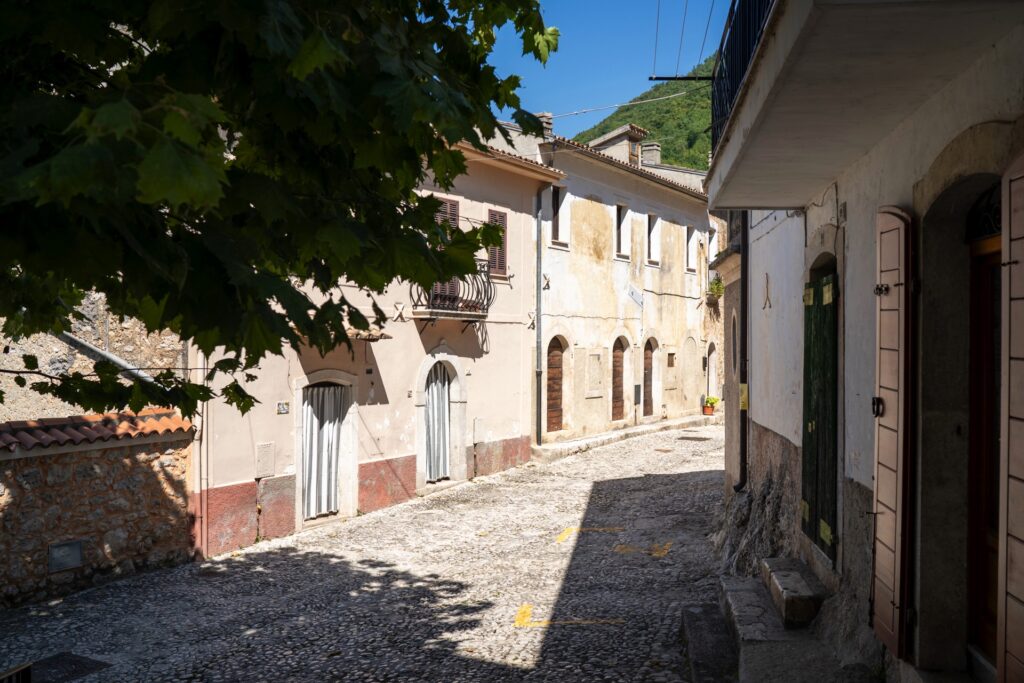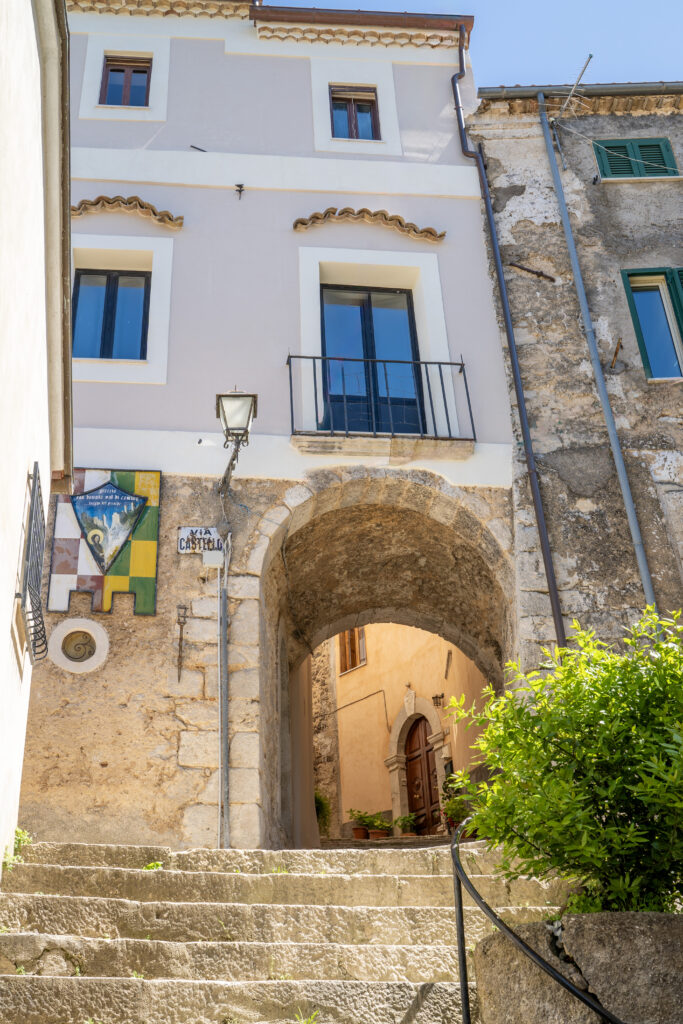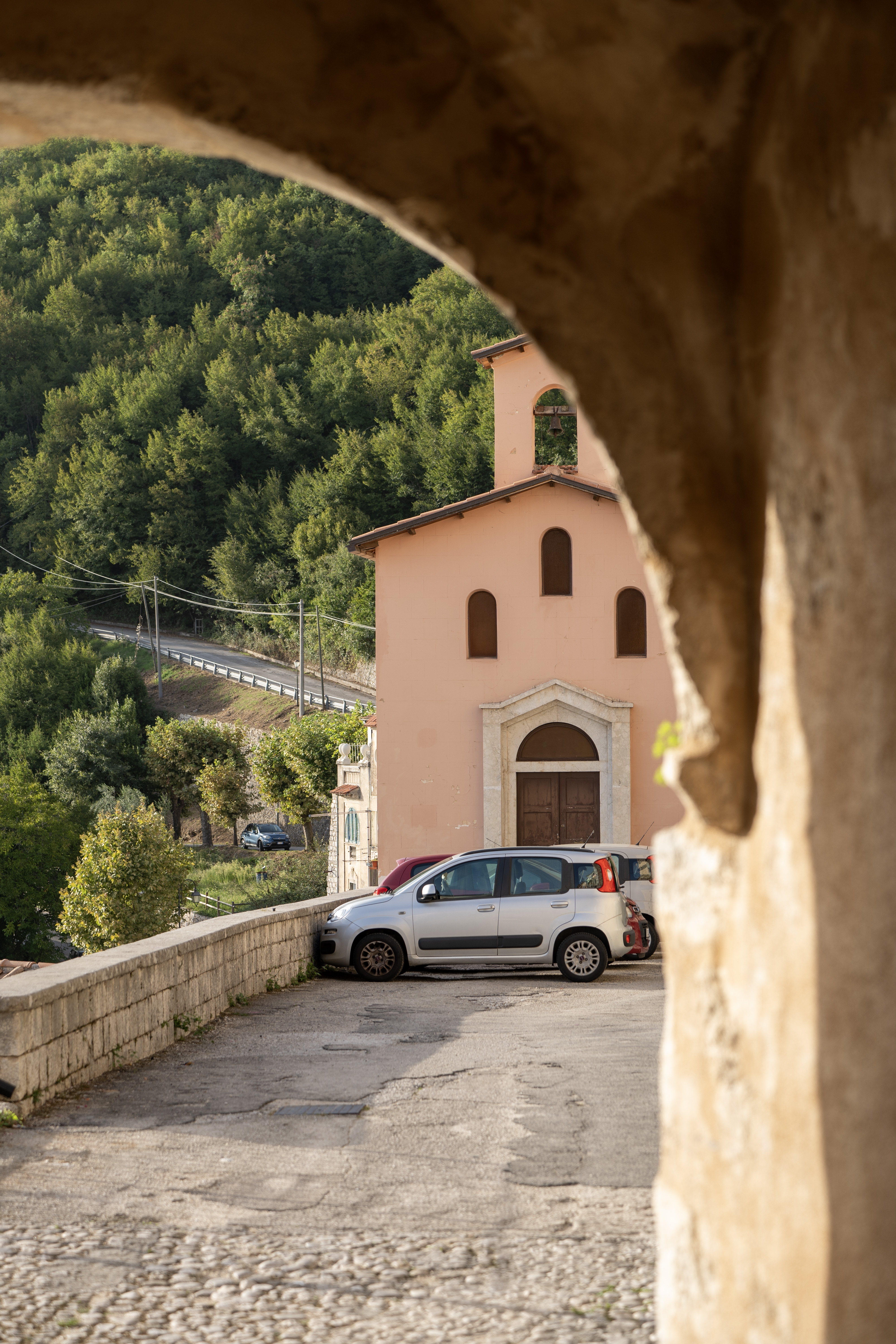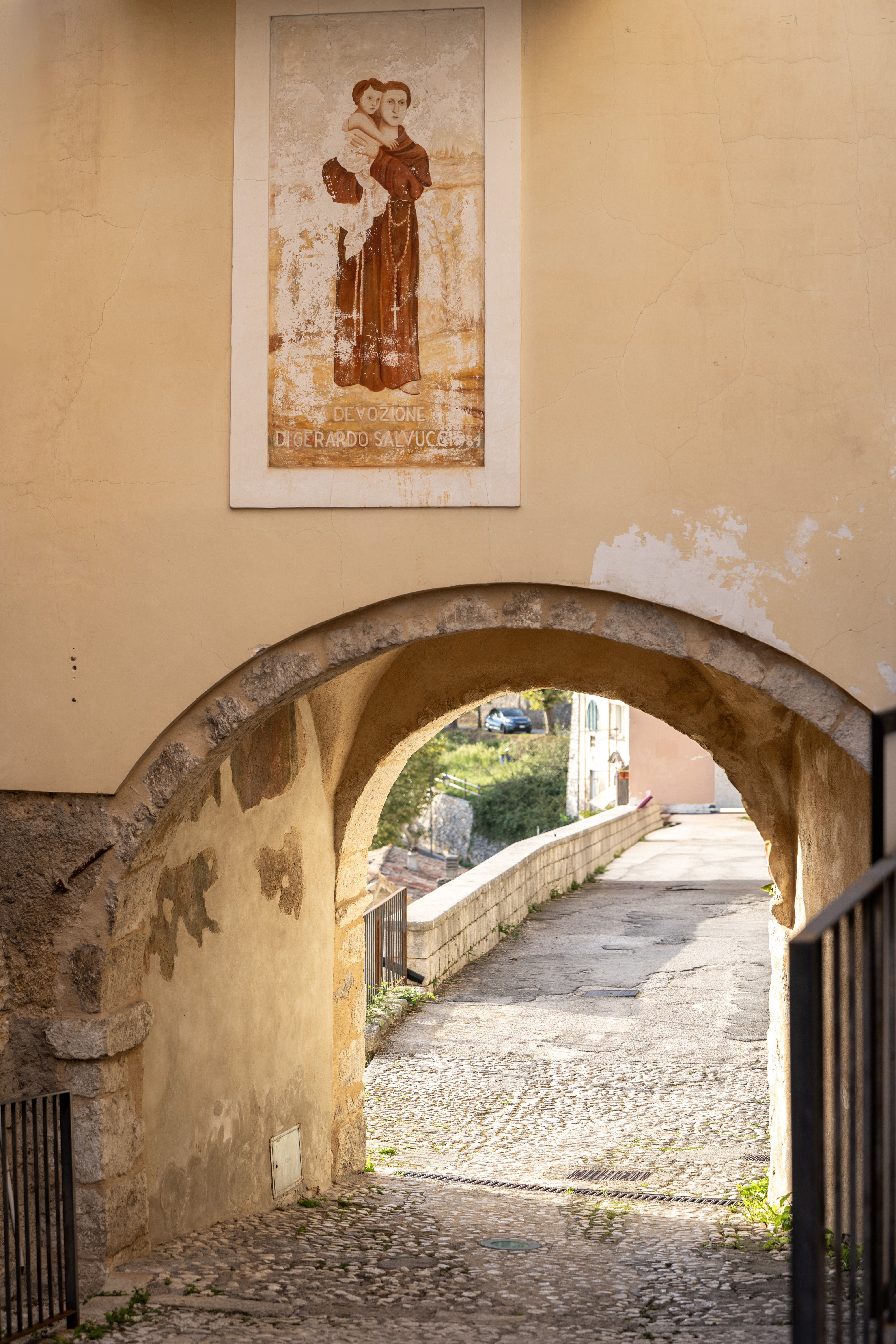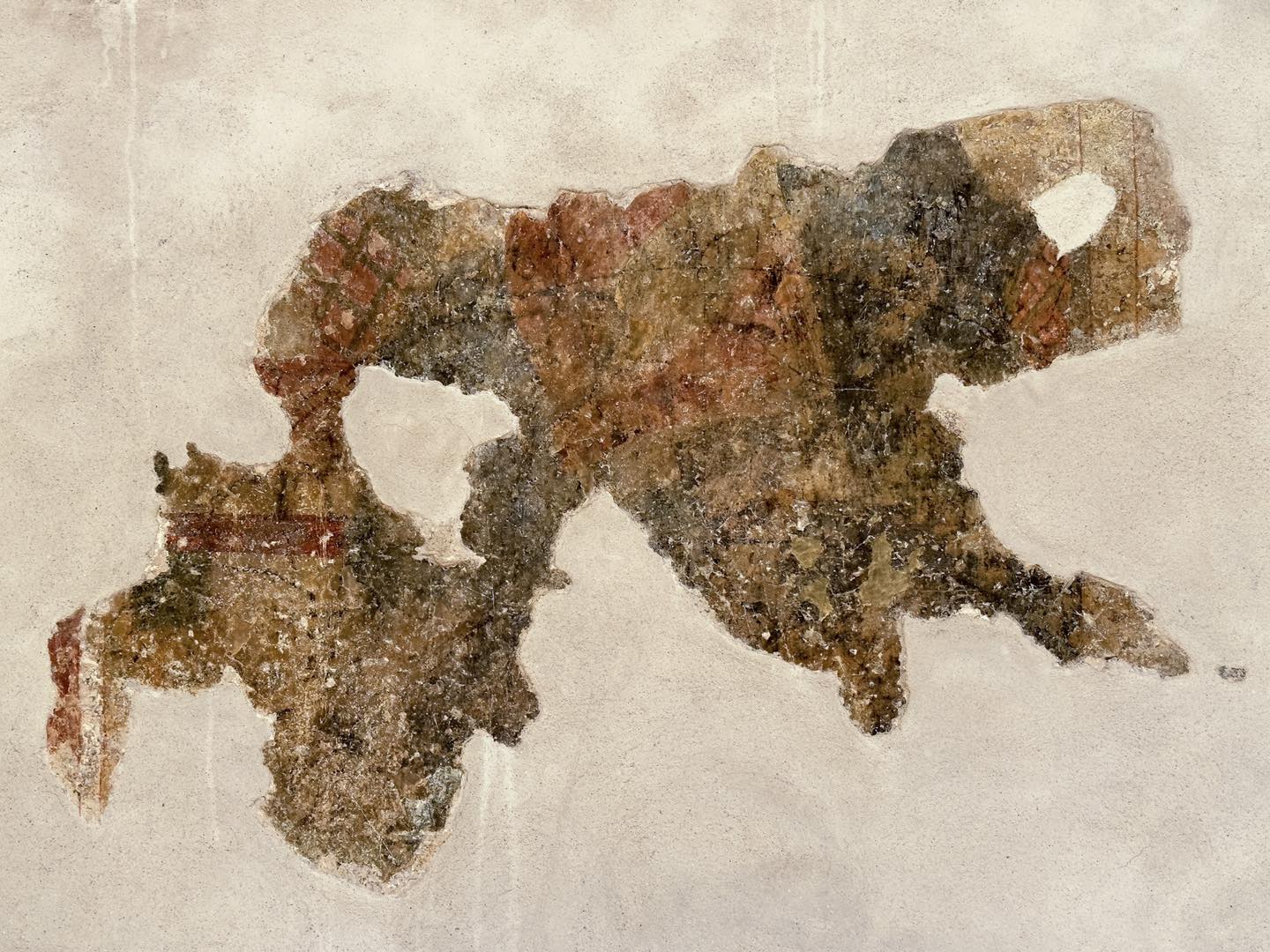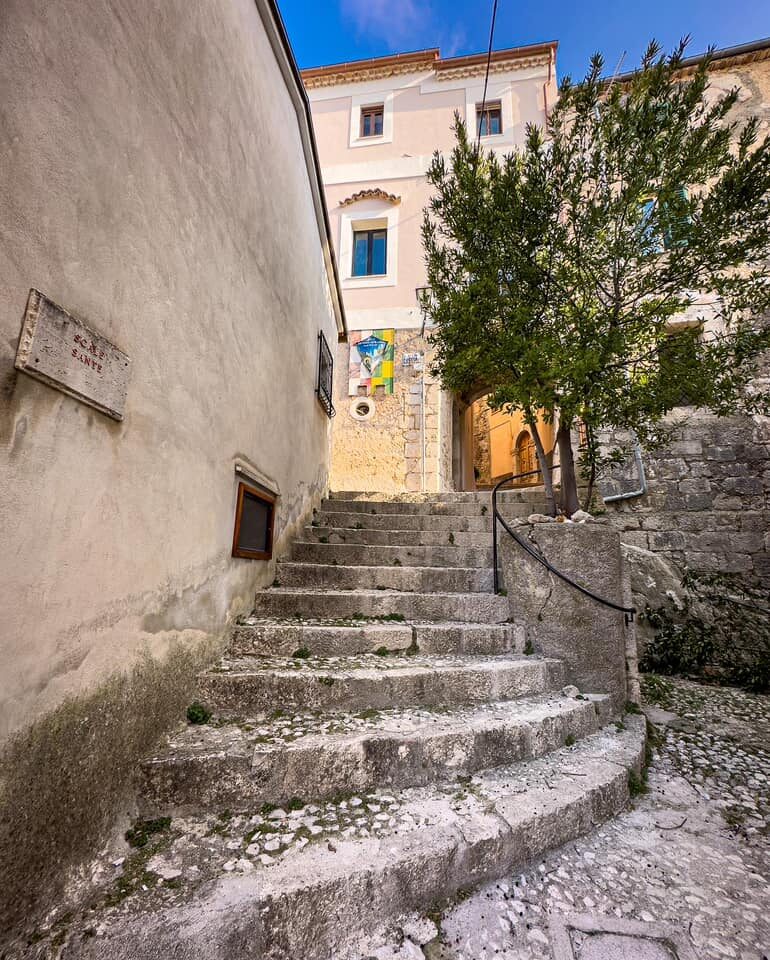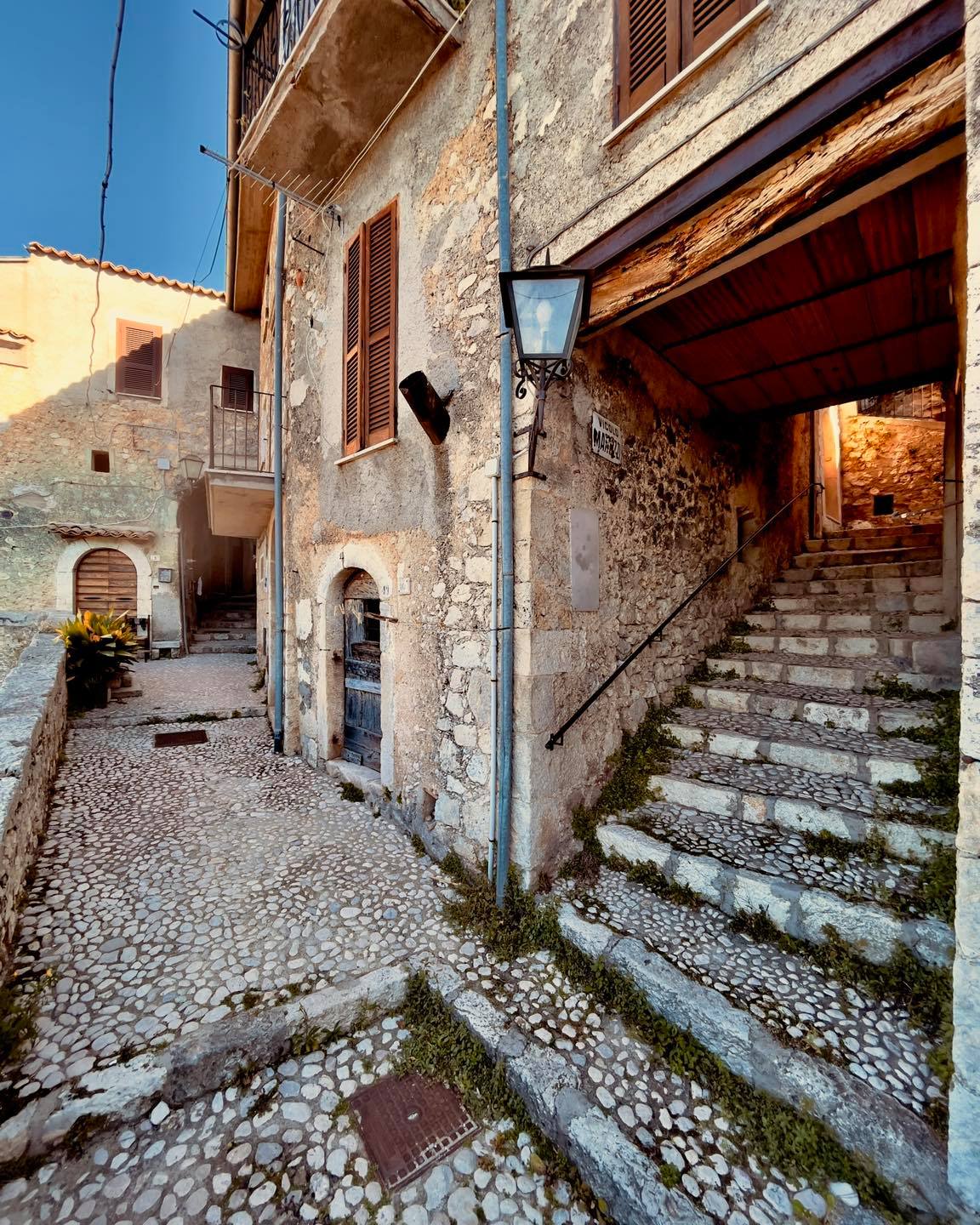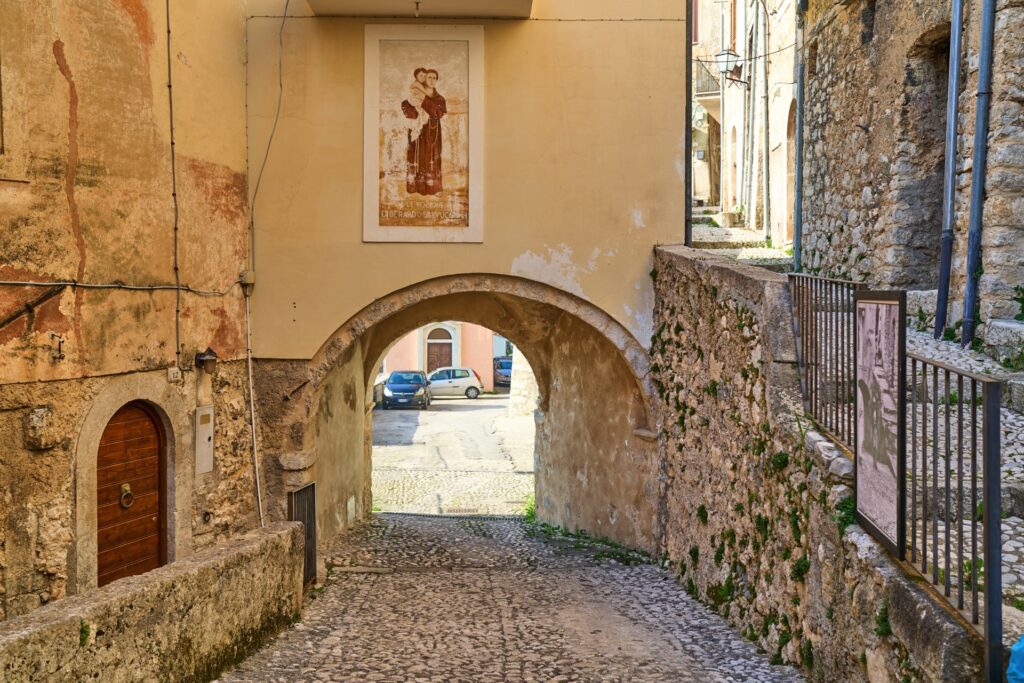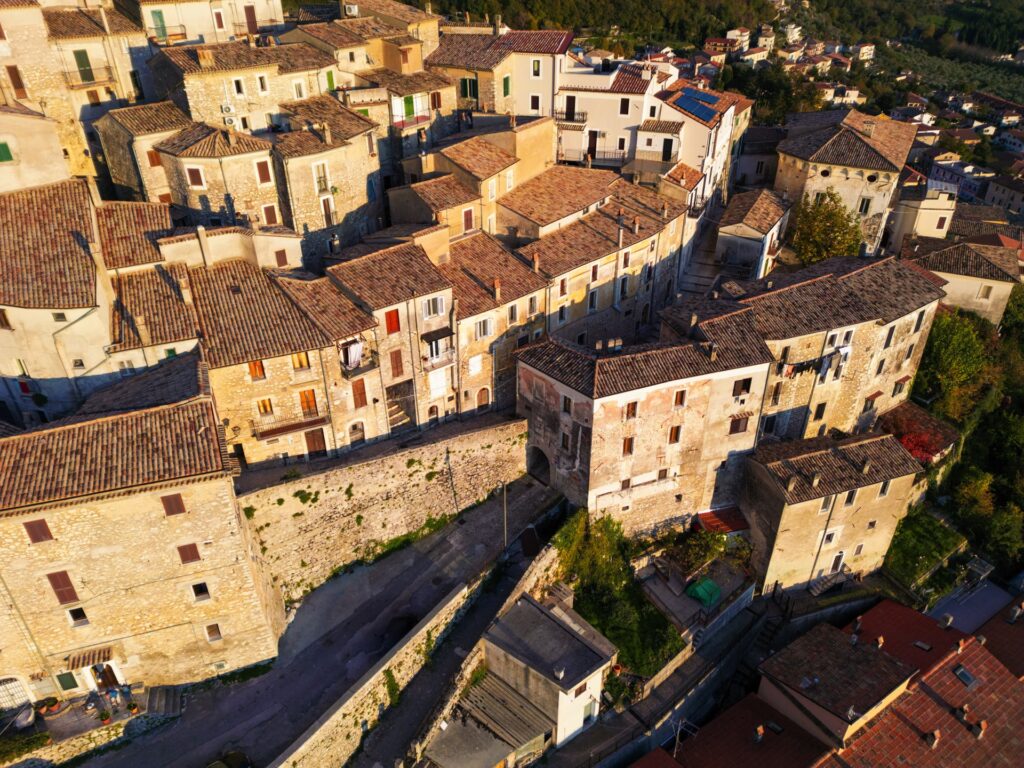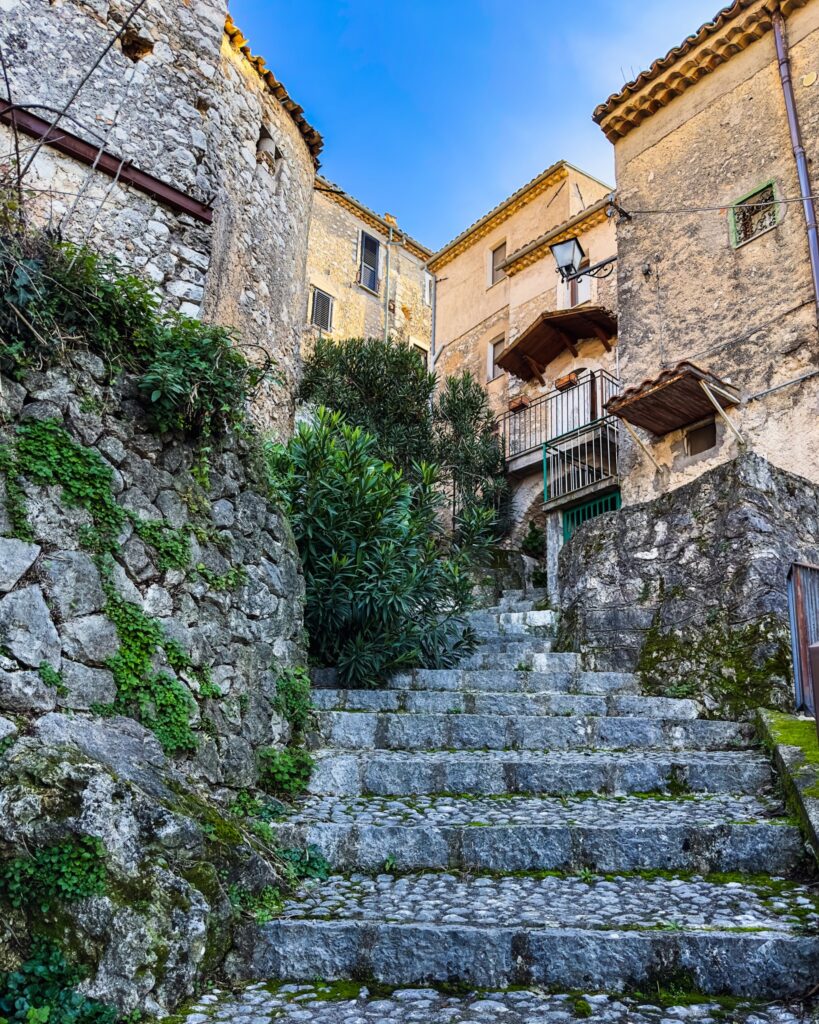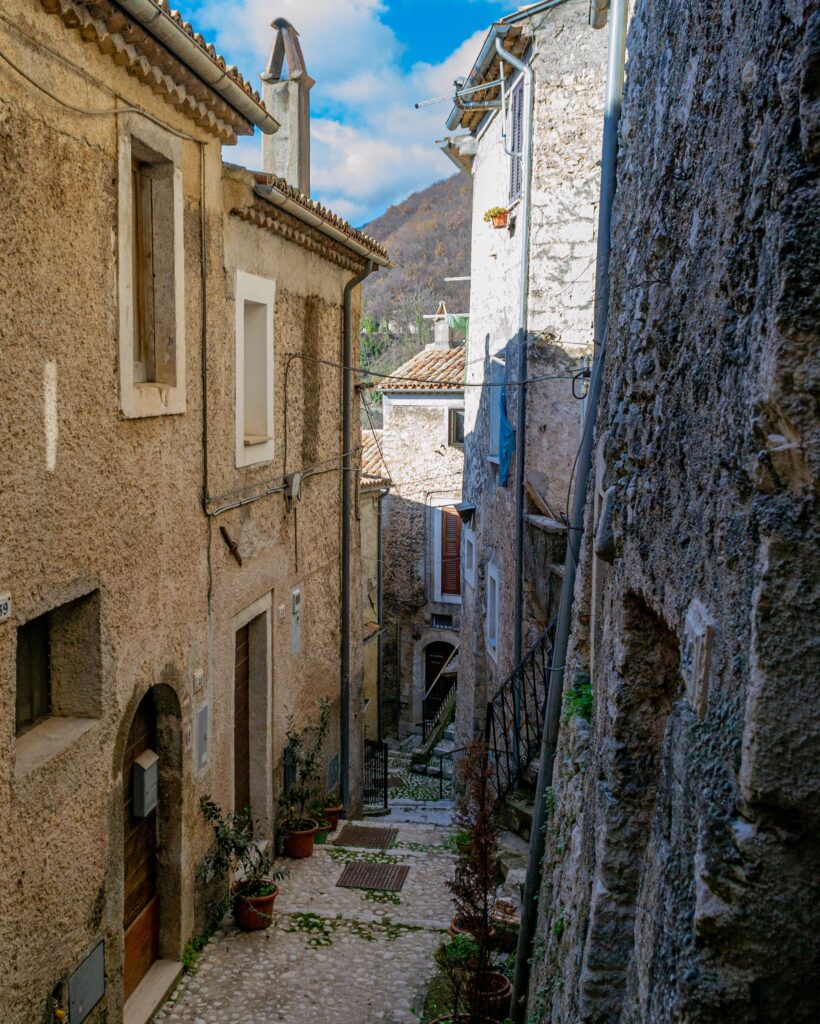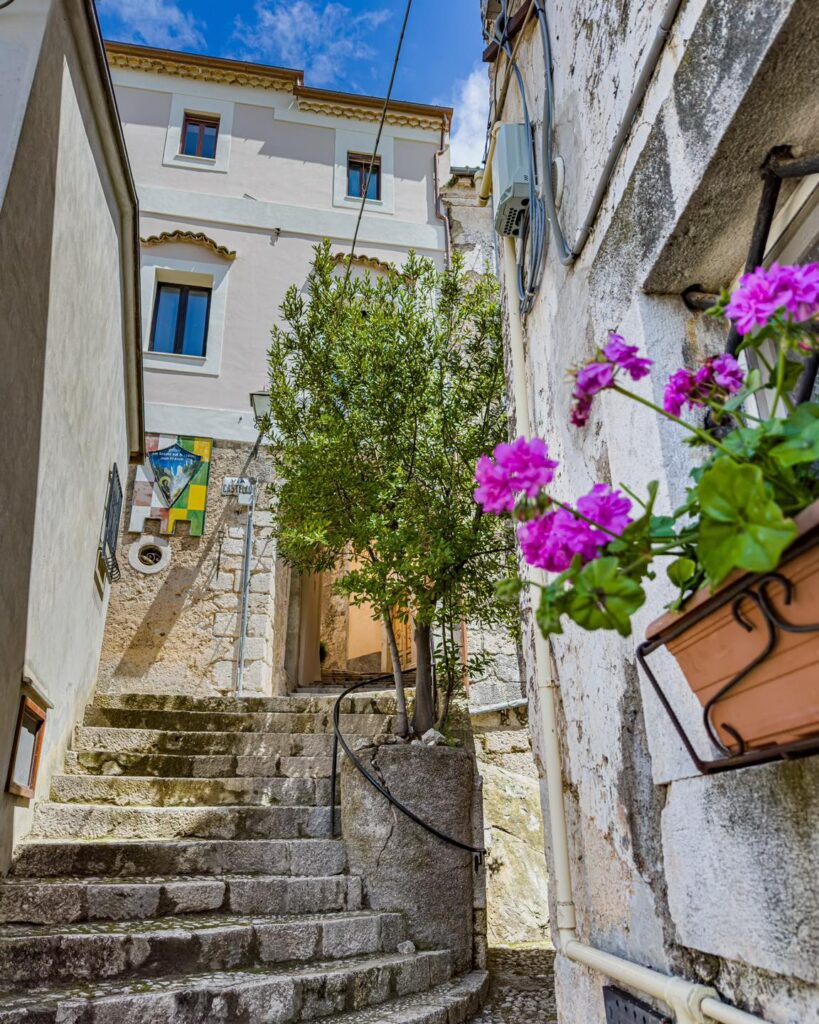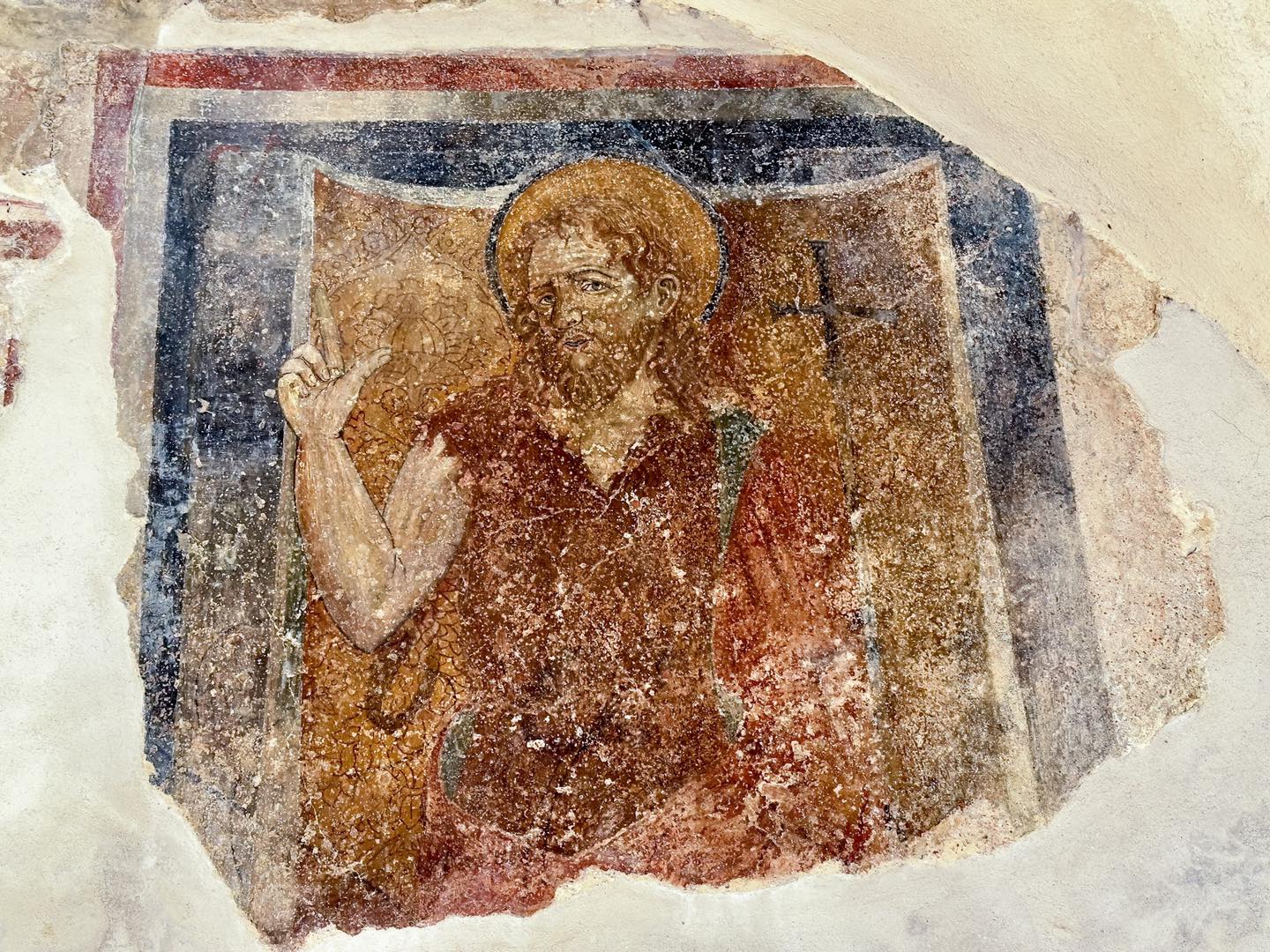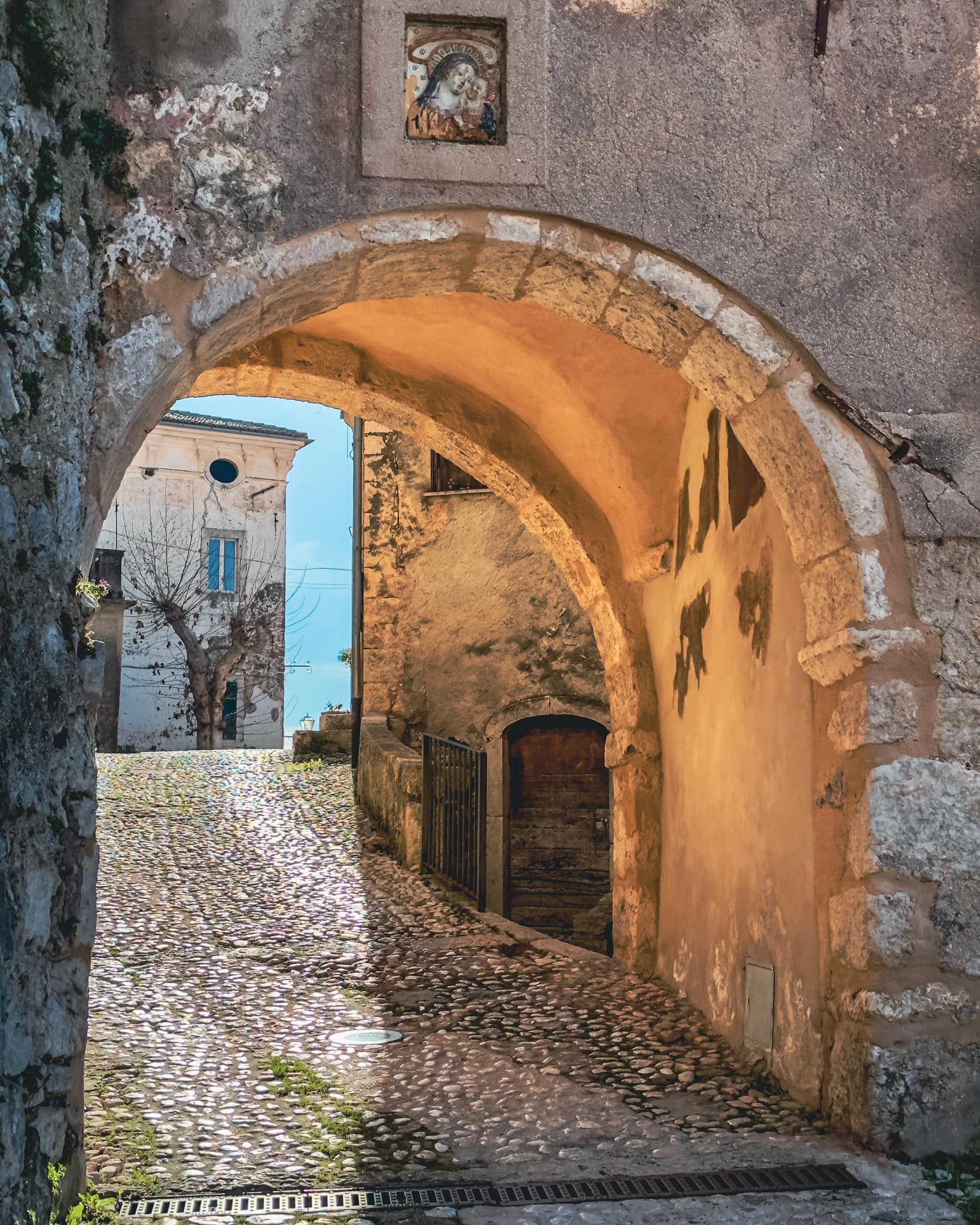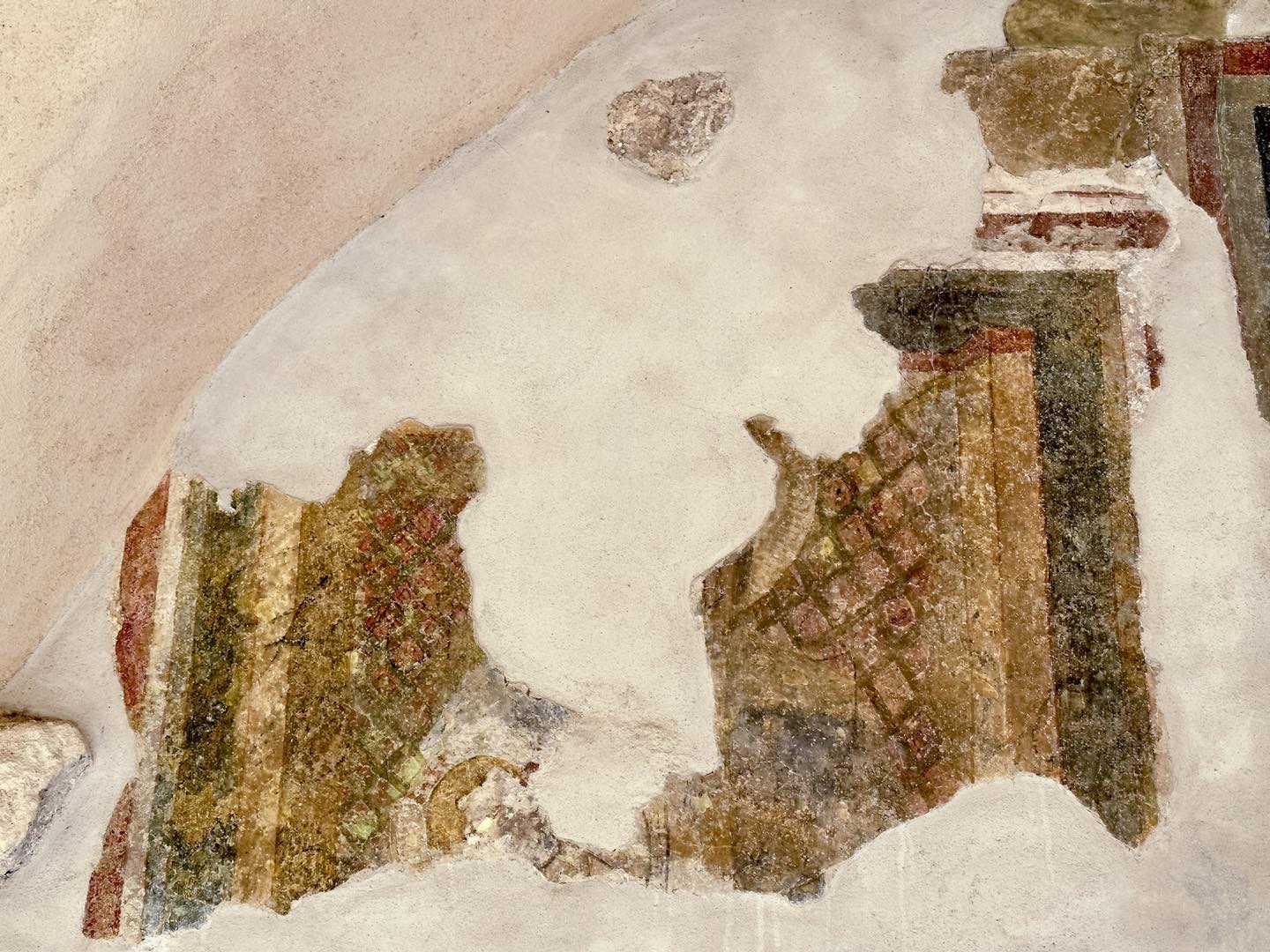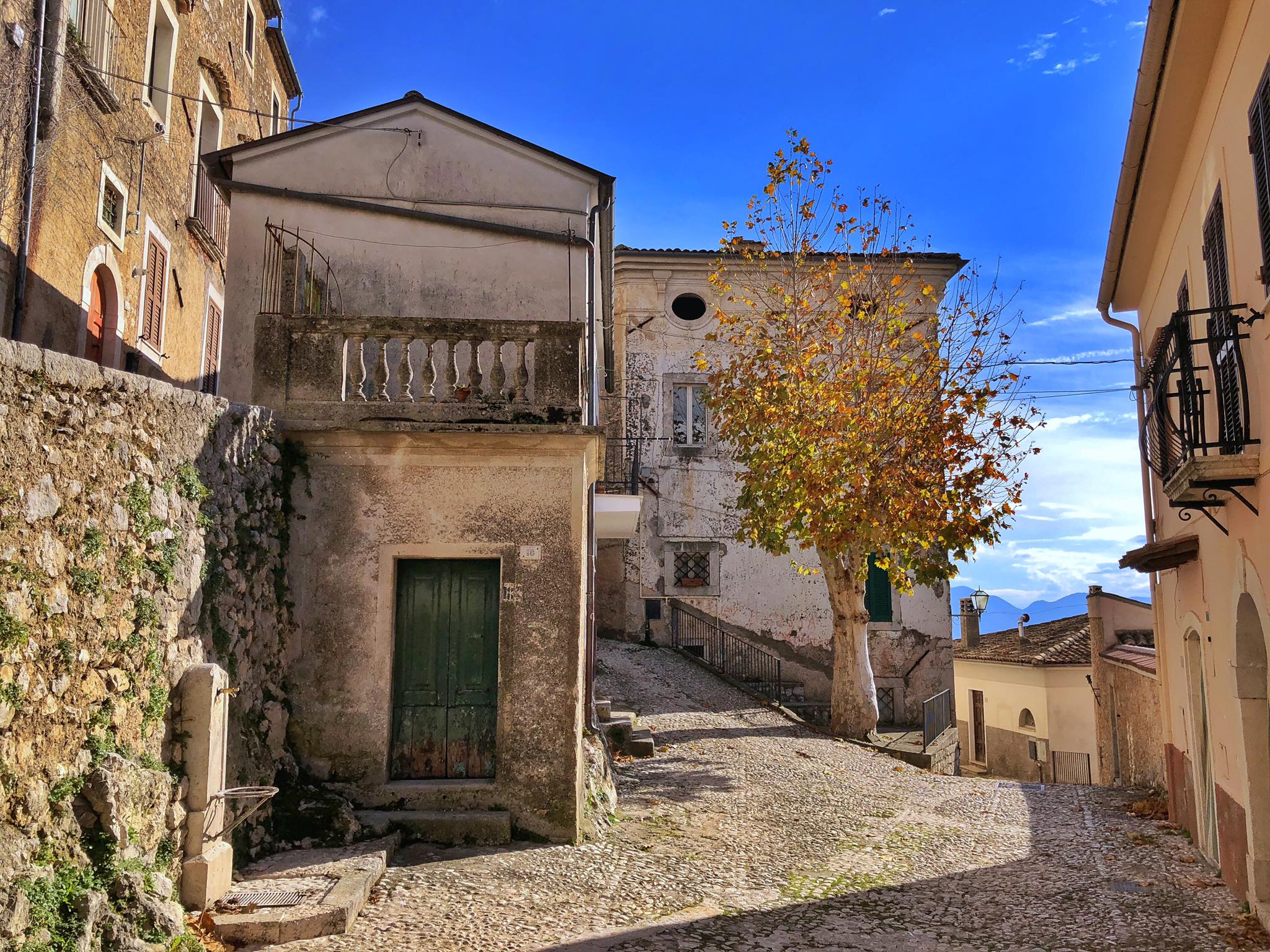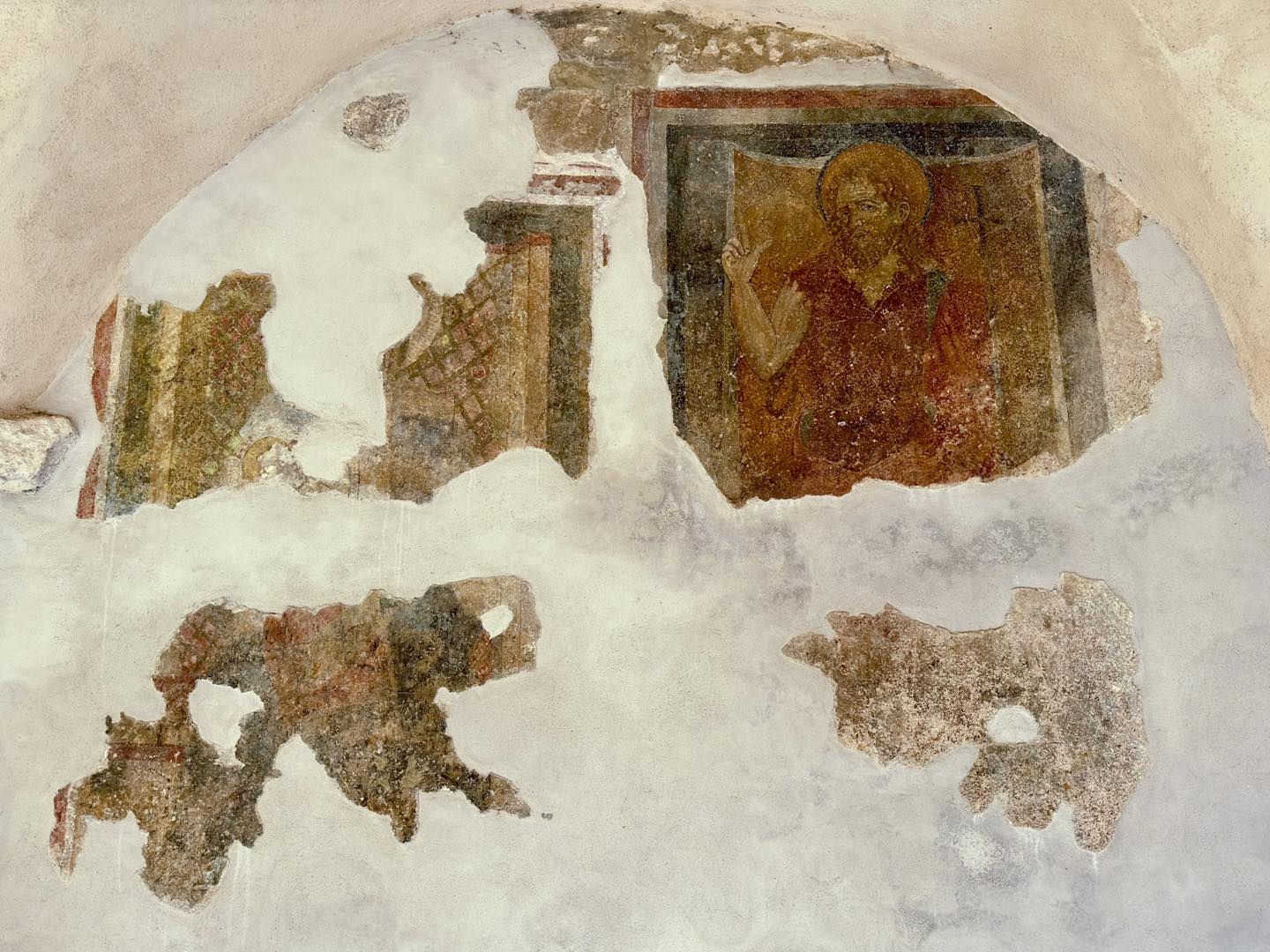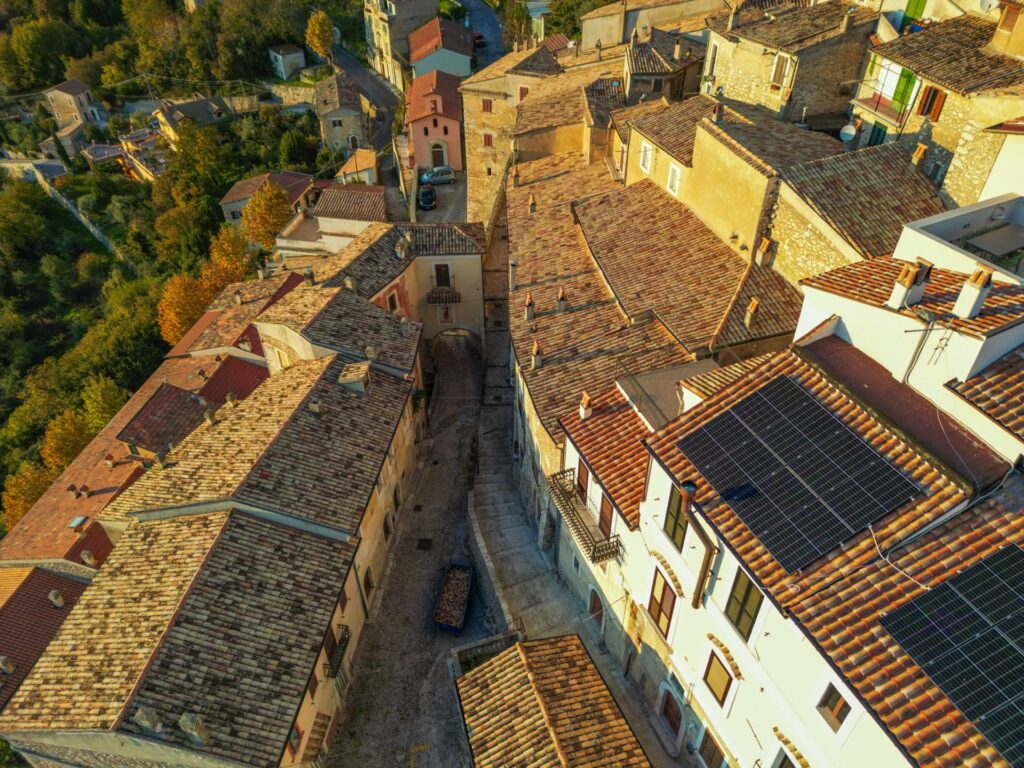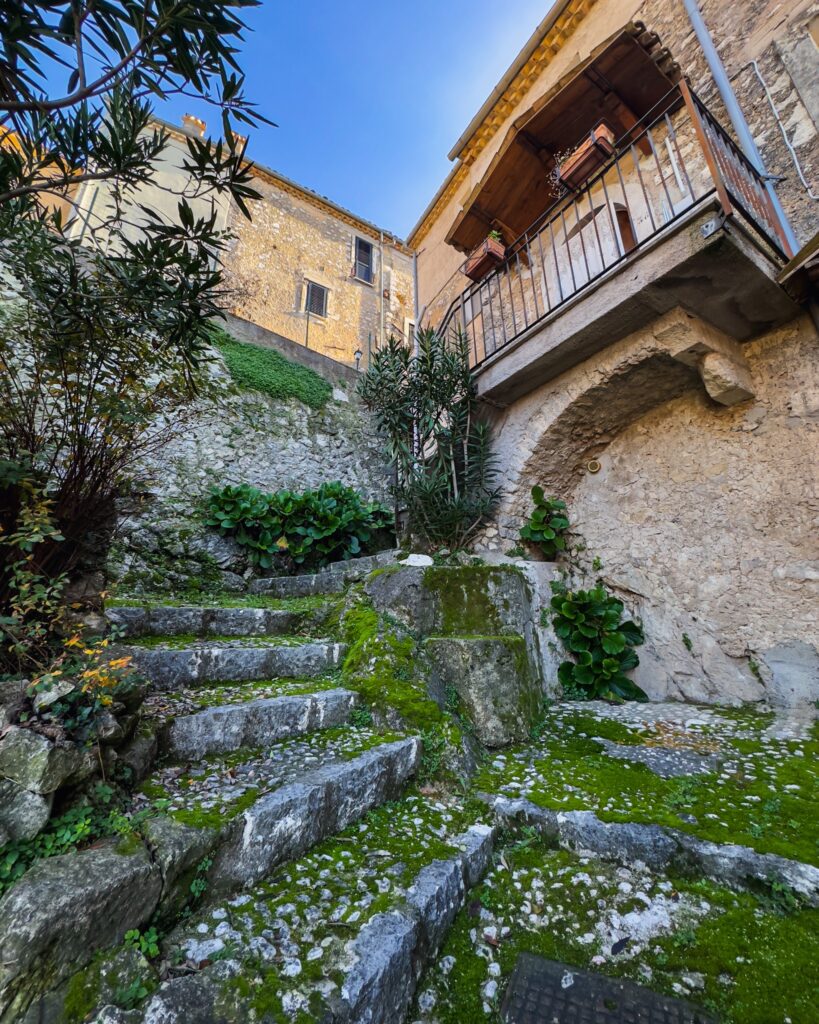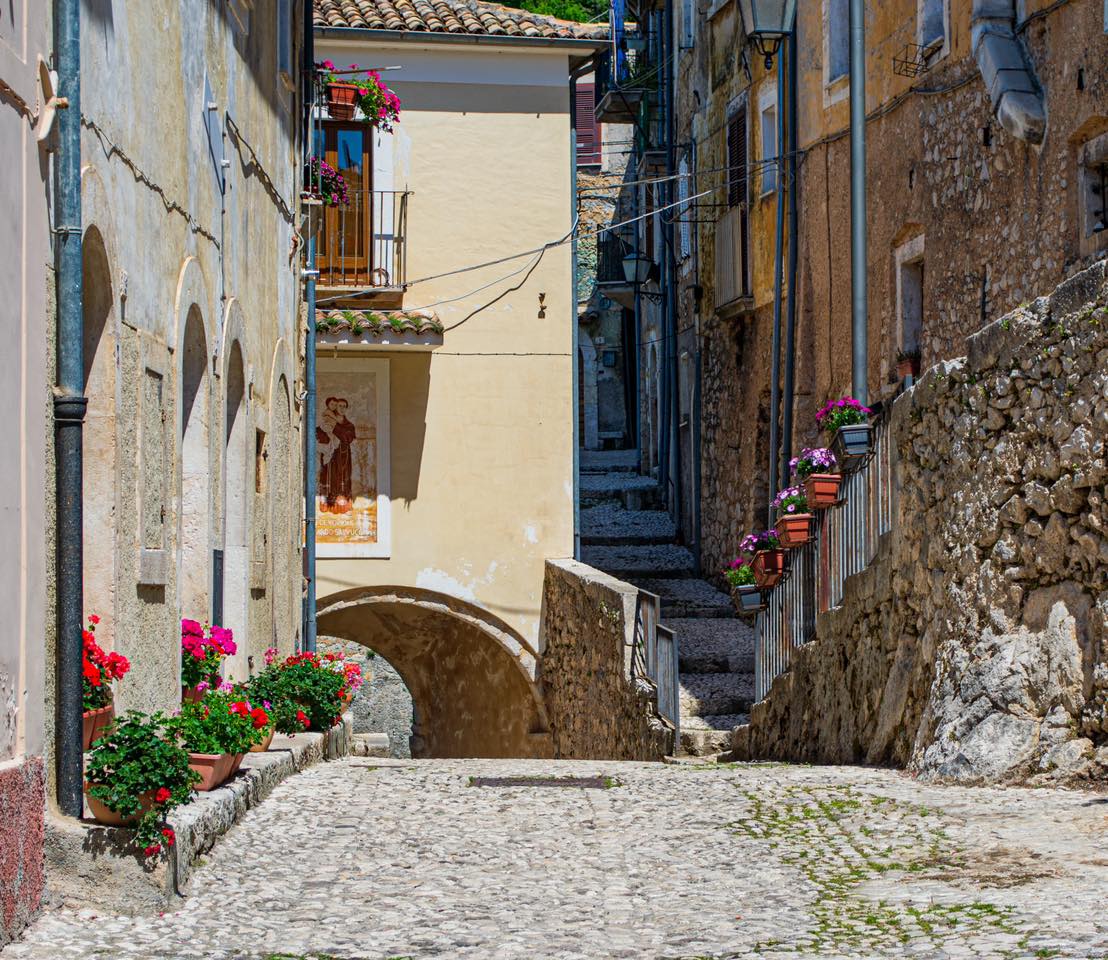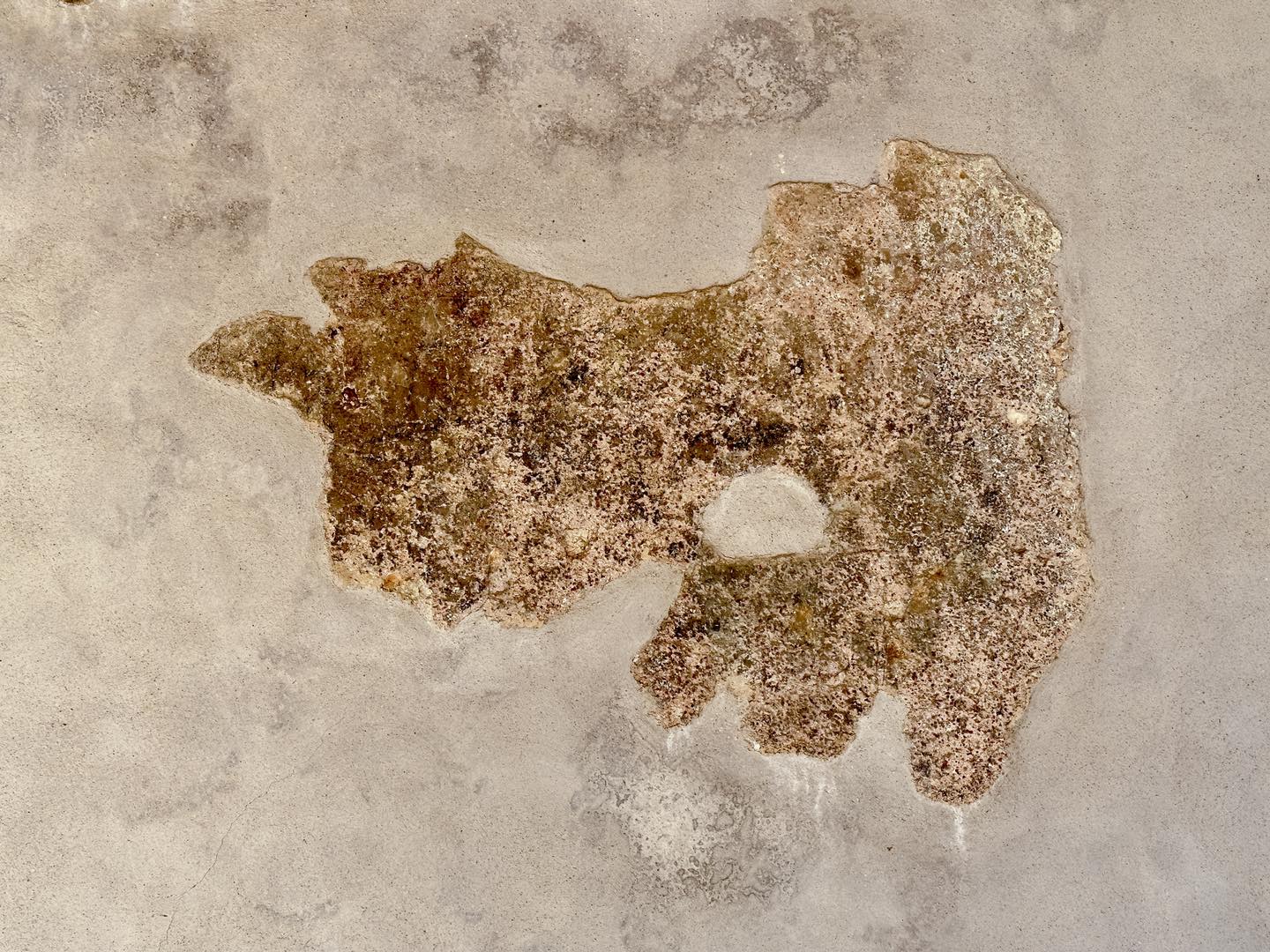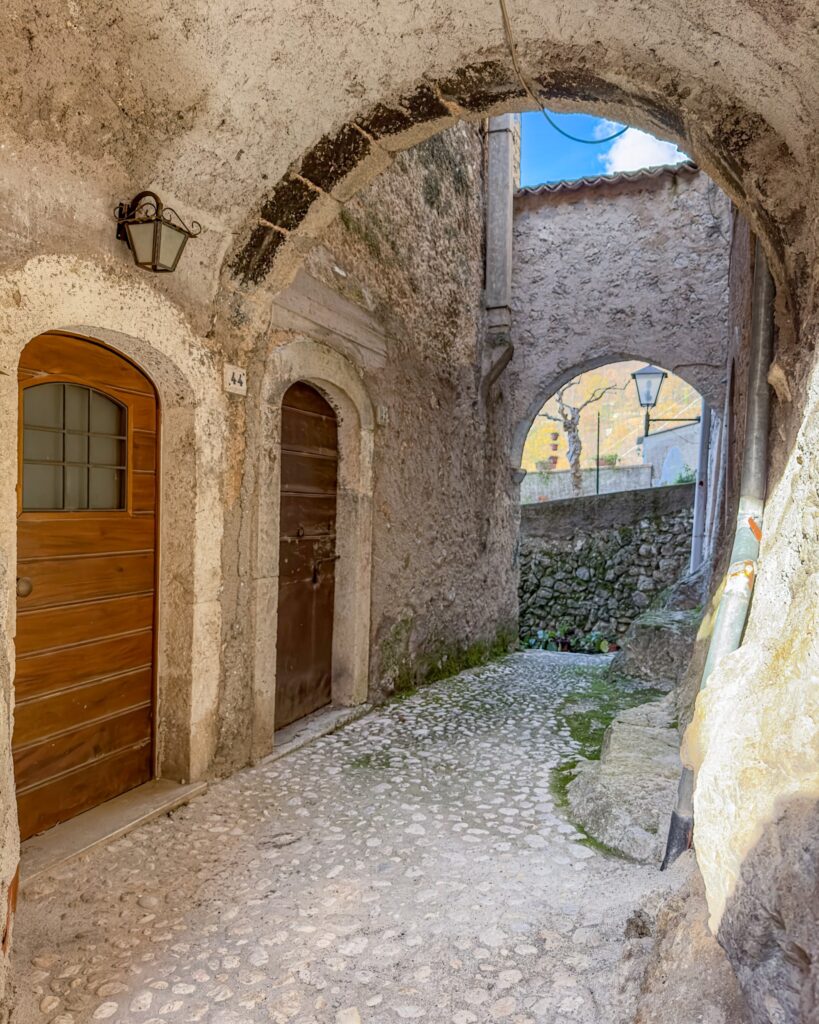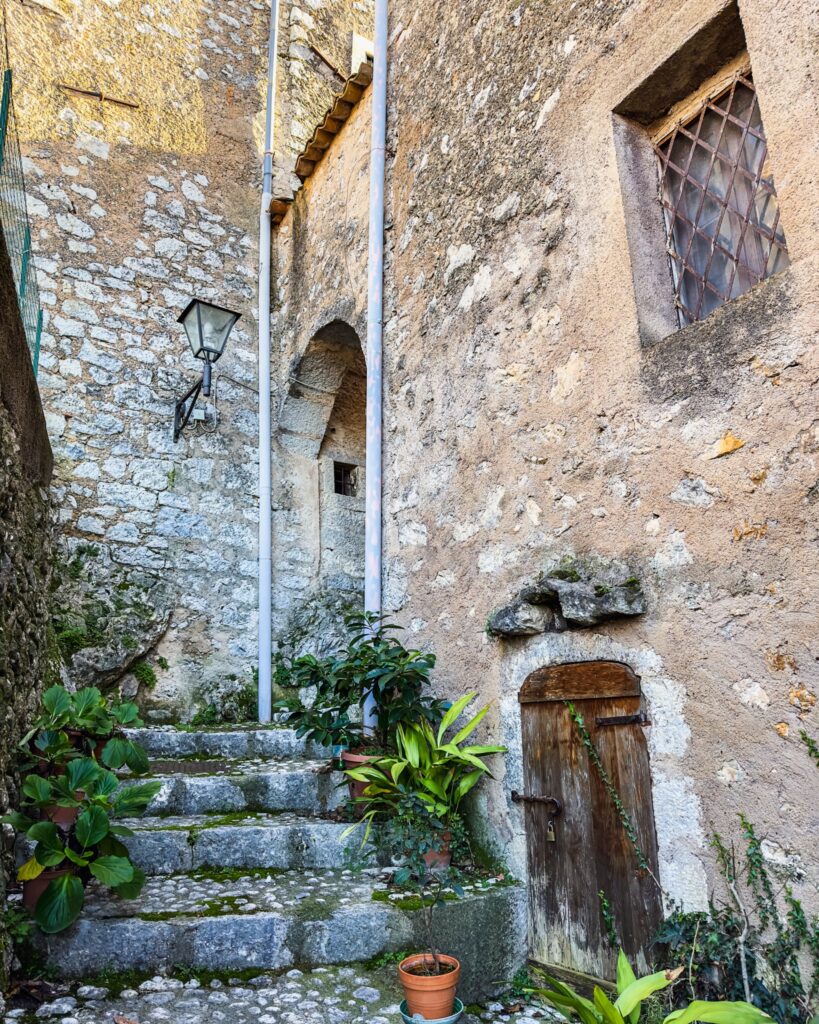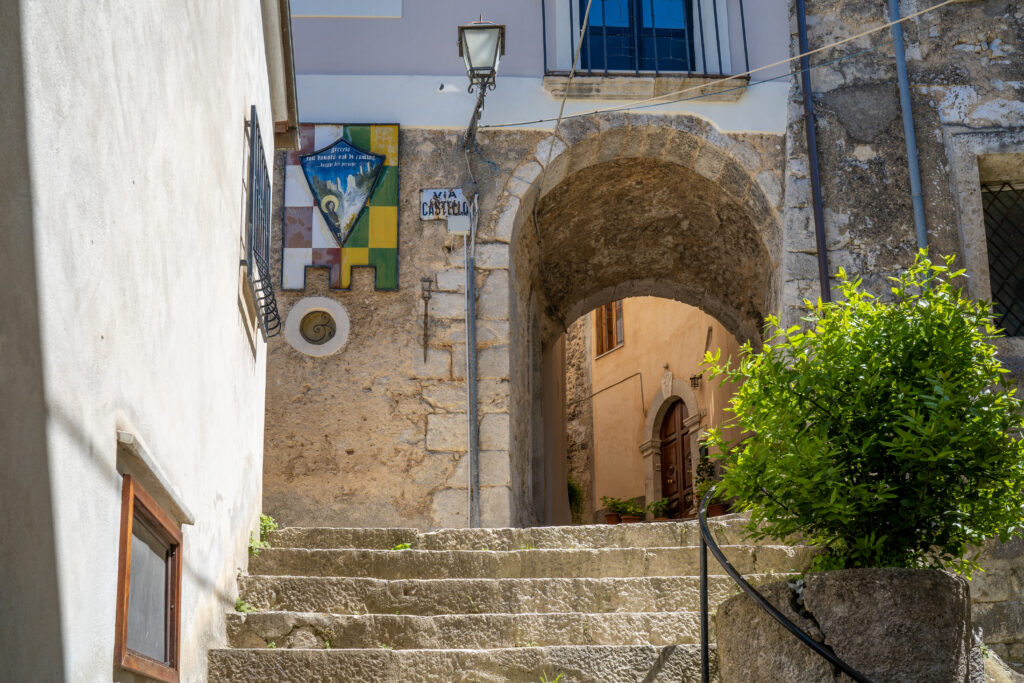Colle Square
Historical landmark
Gate to Master (Castle Gate)
Porta a Maestro, also known as Porta Castello, is one of the gateways to the first nucleus of the village of San Donato Val di Comino. Facing towards Maestro, in the direction of Alvito, the gate controlled the passage way to the valley, while the other gate, the Arch of San Donato, was oriented to the east and supervised traffic coming from Abruzzo along the ancient Via Marsicana.
Porta a Ponente (West Gate) (Porta Colle)
Porta a Ponente, also known as Porta Colle, is a historical and artistic testimony of extraordinary value. Dating back to Angevin times, the wall painting under this gate is estimated to have been created around the 13th century. Although time and weather have reduced its original surface to a few fragments, what remains of the painting depicts St. John the Baptist with evocative power.
The image shows St. John the Baptist wrapped in a cloak made of animal skins, according to biblical tradition, while raising his right hand with his index finger pointing toward heaven, symbolizing the coming of the Savior. In his left hand he holds a black cross, while yellow drapery stands out in the background, giving depth and dynamism to the scene.
This fresco, although fragmentary, stands out for its quality of execution, which denotes its belonging to the Angevin school of painting. It is probable that the original work covered a large part of the arch of the door, according to the typical style of this school, which liked to depict biblical scenes and characters on the arches and vaults of architectural structures.
The Angevin school of painting, particularly active in the Kingdom of Naples between the 13th and 14th centuries, had developed a unique style that blended French, Byzantine, and local influences. The work at Porta a Ponente is one of the few remaining vestiges of this tradition in San Donato Val di Comino, confirming its historical and cultural significance.
The Gate itself, in addition to being a symbolic and functional gateway to the medieval town, represents a key piece in understanding the region's past, a place where history and art intertwine to offer a glimpse of the spirituality and daily life of the Middle Ages. The importance of this fragment also lies in the fact that it allows us to imagine what the entire original painting might have looked like, thus enriching our understanding of the Angevin period and its artistic production.
The holy stairs
The medieval village of San Donato Val di Comino is characterized by a dense network of stairs, steps and terraces that wind through the historic road system. Prominent among these is the Scala Santa, located in Piazza Colle and connected directly to Porta Castello, from which pilgrims could reach the Sanctuary of San Donato. This staircase owes its name to tradition: it was walked on August 6 by devotees who came on foot from all over the surrounding area and beyond to pay homage to St. Donatus, the patron saint of the town.
While in other localities the Holy Stairs are linked to the Passion of Jesus, such as in Rome, Naples or Veroli, the Holy Staircase in San Donato Val di Comino is dedicated to pilgrims and their journey, which culminated in paying homage to the martyr St. Donatus at the shrine located at the foot of Mount Pizzuto. Porta a Maestro thus represents a historical and spiritual symbol of the village, a living testimony to popular devotion and the centrality of San Donato as a place of passage and meeting between peoples and traditions.
Cannesse
This charming cluster of houses sprang up around the fortress and shrine during the era of encastellation. At that time, the new inhabitants decided to build their houses close to the Castle, along the main routes such as sheep-tracks and mule-tracks, forming a compact and charming village.
Cannesse's distinctive doughnut-like morphology suggests a sense of enclosure and protection, highlighting both the isolated lifestyle of the inhabitants of the time and the defensive potential of the structure.
This urban development is particularly evident towards the west, where the village of Cannesse expands the most. This expansion is due to several factors: the conformation of the terrain that is less steep than in the Forca d'Acero valley, a milder climate due to protection from northern winds, and the presence of strategic sheep-tracks.
A significant part of this historic road passes outside the village and leads directly to one of the primitive gates of the castle, located to the northwest.
Marozzi Alley
Marozzi Alley in San Donato Val di Comino is a place full of history and tradition, bearing the name of one of the first families that populated this town.
This alley features unique medieval architecture, with passageways connected by small arcades and steep steps. The winding, narrow shape of the alley was designed to protect the dwellings from the icy wind and to provide greater protection against sieges in the castle walls.
Due to the narrow, labyrinthine streets, attackers were easily struck by blunt objects or boiling water thrown from houses, making Marozzi Alley a real attraction for fans of medieval history and architecture.
This place is a must for those visiting San Donato Val di Comino to immerse themselves in the history and tradition of this charming town.
Porta a Maestro, also known as Porta Castello, is one of the gateways to the first nucleus of the village of San Donato Val di Comino. Facing towards Maestro, in the direction of Alvito, the gate controlled the passage way to the valley, while the other gate, the Arch of San Donato, was oriented to the east and supervised traffic coming from Abruzzo along the ancient Via Marsicana.
Porta a Ponente (West Gate) (Porta Colle)
Porta a Ponente, also known as Porta Colle, is a historical and artistic testimony of extraordinary value. Dating back to Angevin times, the wall painting under this gate is estimated to have been created around the 13th century. Although time and weather have reduced its original surface to a few fragments, what remains of the painting depicts St. John the Baptist with evocative power.
The image shows St. John the Baptist wrapped in a cloak made of animal skins, according to biblical tradition, while raising his right hand with his index finger pointing toward heaven, symbolizing the coming of the Savior. In his left hand he holds a black cross, while yellow drapery stands out in the background, giving depth and dynamism to the scene.
This fresco, although fragmentary, stands out for its quality of execution, which denotes its belonging to the Angevin school of painting. It is probable that the original work covered a large part of the arch of the door, according to the typical style of this school, which liked to depict biblical scenes and characters on the arches and vaults of architectural structures.
The Angevin school of painting, particularly active in the Kingdom of Naples between the 13th and 14th centuries, had developed a unique style that blended French, Byzantine, and local influences. The work at Porta a Ponente is one of the few remaining vestiges of this tradition in San Donato Val di Comino, confirming its historical and cultural significance.
The Gate itself, in addition to being a symbolic and functional gateway to the medieval town, represents a key piece in understanding the region's past, a place where history and art intertwine to offer a glimpse of the spirituality and daily life of the Middle Ages. The importance of this fragment also lies in the fact that it allows us to imagine what the entire original painting might have looked like, thus enriching our understanding of the Angevin period and its artistic production.
The holy stairs
The medieval village of San Donato Val di Comino is characterized by a dense network of stairs, steps and terraces that wind through the historic road system. Prominent among these is the Scala Santa, located in Piazza Colle and connected directly to Porta Castello, from which pilgrims could reach the Sanctuary of San Donato. This staircase owes its name to tradition: it was walked on August 6 by devotees who came on foot from all over the surrounding area and beyond to pay homage to St. Donatus, the patron saint of the town.
While in other localities the Holy Stairs are linked to the Passion of Jesus, such as in Rome, Naples or Veroli, the Holy Staircase in San Donato Val di Comino is dedicated to pilgrims and their journey, which culminated in paying homage to the martyr St. Donatus at the shrine located at the foot of Mount Pizzuto. Porta a Maestro thus represents a historical and spiritual symbol of the village, a living testimony to popular devotion and the centrality of San Donato as a place of passage and meeting between peoples and traditions.
Cannesse
This charming cluster of houses sprang up around the fortress and shrine during the era of encastellation. At that time, the new inhabitants decided to build their houses close to the Castle, along the main routes such as sheep-tracks and mule-tracks, forming a compact and charming village.
Cannesse's distinctive doughnut-like morphology suggests a sense of enclosure and protection, highlighting both the isolated lifestyle of the inhabitants of the time and the defensive potential of the structure.
This urban development is particularly evident towards the west, where the village of Cannesse expands the most. This expansion is due to several factors: the conformation of the terrain that is less steep than in the Forca d'Acero valley, a milder climate due to protection from northern winds, and the presence of strategic sheep-tracks.
A significant part of this historic road passes outside the village and leads directly to one of the primitive gates of the castle, located to the northwest.
Marozzi Alley
Marozzi Alley in San Donato Val di Comino is a place full of history and tradition, bearing the name of one of the first families that populated this town.
This alley features unique medieval architecture, with passageways connected by small arcades and steep steps. The winding, narrow shape of the alley was designed to protect the dwellings from the icy wind and to provide greater protection against sieges in the castle walls.
Due to the narrow, labyrinthine streets, attackers were easily struck by blunt objects or boiling water thrown from houses, making Marozzi Alley a real attraction for fans of medieval history and architecture.
This place is a must for those visiting San Donato Val di Comino to immerse themselves in the history and tradition of this charming town.
Do you want to visit this attraction?
Book your vacation now.
Colle Square,
Marozzi Alley,
123,
03046 San Donato Val di Comino FR,
Italy
-
Vicolo Marozzi, 123, 03046 San Donato Val di Comino FR, Italy
Details
Suitable for
- Childrens, Couples, Families, Groups, Solo travelers
Best season to go
- All the seasons
Duration / time of visit
- Up to 1 hour
Type of tour
- This attraction is part of a guided tour, Small groups tour, Solo tour, Private tour
Are audio guides provided?
- Yes, upon request
Available languages
- English, Italian
Ticket price
- Does not require a ticket
